Table of Contents
ToggleIntroduction
Picture this scenario: you arrive at your home after a tiring day, hoping for a moment of relaxation, only to find out that your once spotless carpet is now soaked and waterlogged, and you cannot leave it unattended because of the potential hazards like mold growth, damage to the floor and foul smell, etc. But worry not, because you’ve just stumbled upon the ultimate guide to dry wet carpet without vacuum.
In this article, we will disclose all the tips, tricks, and DIY hacks that will not only help you dry your wet carpet properly but will also restore it to its former glory.
Assessing the Wet Carpet Situation
Before we dive into the methods of drying a wet carpet without a vacuum at your home, let’s start with a crucial step: assessing the water saturation and finding the root cause. This way, you’ll know exactly what you’re dealing with and can choose the best drying techniques.
First, take a good look at the affected area. Check for standing water or noticeable dampness on the carpet’s surface. Focus on the areas that seem to be the wettest.
Equally important is to figure out where the water is coming from. It could be a plumbing issue, a leak from another room, or a recent spill that seeped into the carpet fibers. Knowing the source helps you fix the problem and prevent further damage.
Once you’ve assessed the situation and identified the water level and its source, you can confidently move on to the next step. Get ready to prep the carpet for drying and learn about effective, natural techniques that’ll speed up the process. With a good understanding of your carpet’s condition and the tips in this article, you’ll be all set to bring your carpet back to its best, no vacuum needed!

Preparing the Carpet for Drying
To get your wet carpet on the road to recovery, it’s essential to prep it properly before diving into the actual drying process. Here are the key steps to create the ideal environment for effective drying:
Step 1: Clear the Area
First things first, remove any furniture, rugs, or items from the wet area. This ensures easy access to the carpet and protects your belongings from potential damage. Find a safe, dry spot within your home to keep them.
Step 2: Absorb Excess Moisture
Next, grab some absorbent towels, cloths, or rags, and start soaking up as much standing water as you can from the carpet. Gently press the towel or cloth onto the wet spots, letting it absorb the moisture. Repeat with fresh towels until no more water is being soaked up.
Step 3: Enhance Air Circulation
Now, let the air flow freely in the room by opening windows and doors, and strategically placing fans. This increased airflow speeds up drying by encouraging evaporation and carrying away moisture from the carpet.
With the area cleared, excess moisture absorbed, and air circulation enhanced, you’ve set the stage for effective carpet drying. These initial steps create the right conditions for the subsequent natural drying techniques to work their magic.
How to Dry Wet Carpet Without Vacuum?
When it comes to drying a wet carpet without relying solely on a vacuum, harnessing the power of natural drying techniques can be highly effective. These methods utilize natural techniques to speed up the evaporation process and restore your carpet to its dry and unsoiled state.

Utilize Natural Heat
Take advantage of sunlight and warm temperatures to aid in drying your wet carpet. Open windows and doors to allow the warmth of the sun to penetrate the room and accelerate evaporation. If possible, position the wet carpet in direct sunlight to maximize its exposure. The combination of natural heat and airflow can significantly contribute to the drying process.

Use Dehumidifier
Implement dehumidifiers to reduce moisture levels in the room. These devices extract excess humidity from the air, aiding in the drying process by creating a drier environment. Set the dehumidifier to an appropriate level, considering the manufacturer’s guidelines, to effectively remove moisture from the air. Regularly empty the collected water to maintain the device’s optimal performance.
Use Fans
Utilize fans to enhance airflow and promote evaporation. Place them strategically around the wet carpet, directing the airflow toward the damp areas. The continuous movement of air helps to expedite moisture removal and aids in preventing the growth of mold and mildew. Adjust the fans to different angles periodically to ensure even drying across the carpet’s surface.
Use Salt
Salt is a natural moisture absorber. Begin by sprinkling a generous amount of table salt over the damp areas of the carpet. Allow the salt to sit for several hours depending on the level of moisture. Once the salt appears damp or clumped, carefully sweep it up using a carpet sweeper.
Use Baking Soda
Wet carpets often come with unpleasant odors. Baking soda is a natural deodorizer that can help neutralize these odors while aiding in the drying process. Sprinkle a generous amount of baking soda over the damp carpet and gently work it into the fibers using a soft brush or broom. Leave the baking soda to sit for a few hours or overnight, allowing it to absorb odors and excess moisture. Finally, remove the baking soda using a carpet sweeper or using a broom.
Use Towels
Similar to the initial step of absorbing excess moisture, the towel pressing method provides a focused approach to target specific wet areas. Place clean, absorbent towels or cloths over the damp sections of the carpet and press down firmly. This pressing action helps transfer moisture from the carpet fibers to the towels. Repeat the process with fresh towels until you no longer observe significant moisture absorption.
Use a Hairdryer
For smaller areas or localized wet spots, a hairdryer can be a valuable tool. Set the hairdryer to a low or medium heat setting and hold it several inches away from the wet carpet. Gently move the hairdryer back and forth over the damp area, allowing the warm air to aid in evaporation. Be cautious not to overheat the carpet or hold the hairdryer too close, as this may cause damage.
Use Heaters
Portable heaters can be used to aid in drying a wet carpet. Ensure that the heater is placed in a safe location away from any flammable materials. Open windows or doors to allow for adequate airflow while using the heater. This helps in preventing excessive humidity buildup in the room. Position the heater at a safe distance from the wet carpet, directing the warm air toward the damp areas.
Avoid setting the heater to high temperatures, as this may risk overheating or scorching the carpet. Keep an eye on the drying progress and periodically check the moisture levels in the carpet. Adjust the heater’s position or intensity as needed to ensure even and efficient drying.
Professional Assistance
Professional carpet cleaners possess the expertise, equipment, and experience to effectively address extensive water damage and ensure thorough drying.
Following are some of the situations where seeking professional assistance for drying a wet carpet may be the only option.
Extensive Water Damage
If the water damage to your carpet is extensive, such as from a major flood, burst pipes, or sewage backup, it is advisable to consult professionals. They have the knowledge and resources to handle severe water damage scenarios, which may require specialized equipment and advanced drying techniques to mitigate potential risks.
Time-Sensitive Situations
In time-sensitive situations where immediate action is necessary to prevent further damage, professional assistance is crucial. A quick response can significantly minimize the potential for long-term consequences. Professionals can assess the situation promptly, implement appropriate drying methods, and provide advice on necessary repairs or replacements.
Expertise and Equipment
Professional carpet cleaners and water damage restoration specialists possess specialized knowledge and training in dealing with wet carpets. They have access to professional-grade equipment, including powerful extractors, industrial fans, and dehumidifiers, which can speed up the drying process and ensure thorough moisture removal. Their expertise and resources can help restore your carpet to its pre-damaged condition efficiently.
Hazards of Leaving Wet Carpets Unattended
As a carpet cleaning expert with years of experience, I’ve seen the consequences of neglecting wet carpets. When carpets are soaked and left unattended for a prolonged period, they pose several hazards to both human health and the surrounding environment. It’s essential to address these issues promptly to prevent potential risks.
Mold and Mildew Growth
One of the most significant hazards of leaving wet carpets unattended is the rapid growth of mold and mildew. These fungi thrive in damp environments, and carpets provide the perfect breeding ground. Mold and mildew release spores into the air, which can lead to respiratory problems when inhaled.
Dust and Hair Buildup
If a carpet is left wet, it can absorb more dust and hair. Wet carpets have a higher attraction to particles, as the moisture can act as a sticky surface. Dust and hair in the air can cling to the damp fibers, making the carpet appear dirtier and more difficult to clean.
Health Issues
Wet carpets can seriously impact human health, especially for individuals who are sensitive or prone to allergies. As mold and mildew develop, they release allergens and mycotoxins, which can cause a range of health problems, including:

Respiratory Distress
Inhaling mold spores can lead to breathing difficulties, wheezing, coughing, and exacerbate asthma symptoms.
Skin Irritation
Direct contact with wet carpets contaminated with mold can cause skin rashes and irritation.
Allergic Reactions
Some people may experience sneezing, runny nose, itchy eyes, and other allergic reactions due to exposure to mold and its byproducts.
Headaches and Fatigue
Prolonged exposure to mold can also lead to headaches, fatigue, and overall feelings of unwellness.
Foul Odors
Leaving carpets wet for an extended period can result in foul odors permeating the indoor air. These odors are often musty and unpleasant, making the indoor environment uncomfortable and uninviting.
Damage to the Carpet and Flooring
Persistent moisture can lead to irreversible damage to the carpet fibers and the underlying flooring material. Over time, the wet carpet may lose its structural integrity, and the flooring beneath it may warp or rot, requiring expensive repairs or replacements.
Attracting Pests
Wet carpets can attract pests, such as insects and rodents, seeking moisture and food sources. Infestations can be challenging to manage once they have taken hold in your home, leading to further health risks and property damage.
Conclusion
Effectively drying a wet carpet without relying solely on a vacuum is a task that requires a combination of natural drying techniques, DIY tricks, and, in some cases, professional assistance. By understanding the dangers of wet carpets, assessing the situation, and preparing the carpet for drying, you can lay the foundation for successful restoration. Leveraging natural drying techniques, such as utilizing natural sunshine, dehumidifiers, and fans, allow you to harness the power of the environment. Employing DIY tricks like salt absorption, baking soda deodorizing, towel pressing, and utilizing heaters as supplementary tools can further enhance the drying process. However, in cases of extensive water damage or time-sensitive situations, seeking professional assistance is crucial.
With these insights and techniques at your disposal, you can tackle the challenge of drying a wet carpet effectively, restore its condition, and create a clean and fresh living environment.
Frequently Asked Questions
Can we use an air conditioner to dry a wet vacuum?
No, it is not recommended to use an air conditioner to dry a wet carpet. Air conditioners are designed to cool the air and remove humidity from the environment, rather than actively dry wet surfaces. Attempting to use an air conditioner for drying purposes may not only be ineffective but can also potentially damage the air conditioning unit itself.
How long does it take for the carpet to dry naturally?
The time it takes for a carpet to dry naturally depends on various factors such as the carpet’s thickness, humidity levels, and airflow in the room. On average, it may take anywhere from 6 to 24 hours for a carpet to dry completely. However, in some cases, it could take longer, especially in high-humidity conditions or if the carpet is heavily soaked.
Can a wet carpet be saved?
Yes, a wet carpet can often be saved, but prompt and proper action is crucial. The key is to act quickly to prevent mold and mildew growth. Start by removing excess water with towels or a wet vacuum, and then use fans and open windows to enhance airflow and aid in the drying process. It’s essential to address the source of water and fix any leaks or issues. If the carpet remains damp for an extended period or if mold has already developed, it may be challenging to salvage, and professional assistance might be necessary. Acting swiftly is the best chance to successfully save a wet carpet.
- How to Make a Homemade Pet Odor Remover for Carpet Cleaner Machines - July 5, 2025
- Best Vacuum Cleaner for Carpets - April 29, 2024
- How to Get Dried Paint Off Laminate Floor - February 3, 2024